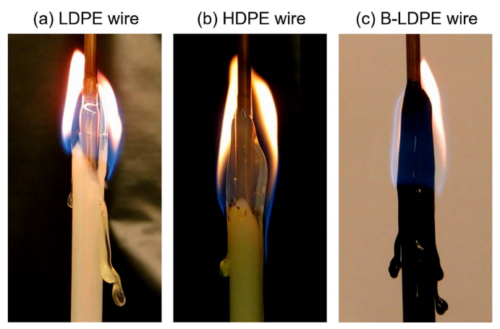Researchers:
Lauren Gagnon, Carlos Fernandez-Pello
 Electrical wires with flammable polymer insulation and metal core are responsible for fire accidents in space exploration missions, because of poor contact, short circuiting, external heating, and ground fault, electrical wires and harnesses are easy to ignite. As a support for “International Standard of Space Fire Safety”, the focus of this research is to understand the changes in flammability of electrical wires under external radiation in the environment expected in space-based facilities. Experiments are first designed and conducted in normal gravity to measure the limiting oxygen concentration (LOC) and flame spread rate for different wire core conditions and insulation materials. The melting and dripping (see video) of the wire insulation are also investigated. Meanwhile, the numerical simulations of wire combustion are conducted to predict potential wire fires in the conditions expected in microgravity and Space Exploration Atmospheres (SEA).
Electrical wires with flammable polymer insulation and metal core are responsible for fire accidents in space exploration missions, because of poor contact, short circuiting, external heating, and ground fault, electrical wires and harnesses are easy to ignite. As a support for “International Standard of Space Fire Safety”, the focus of this research is to understand the changes in flammability of electrical wires under external radiation in the environment expected in space-based facilities. Experiments are first designed and conducted in normal gravity to measure the limiting oxygen concentration (LOC) and flame spread rate for different wire core conditions and insulation materials. The melting and dripping (see video) of the wire insulation are also investigated. Meanwhile, the numerical simulations of wire combustion are conducted to predict potential wire fires in the conditions expected in microgravity and Space Exploration Atmospheres (SEA).
This work is a part of “Flammability Limits at Reduced-g Experiment” (FLARE) project which aims to (1) develop a methodology to correlate material flammability limits in normal and microgravity, and (2) allow quantitative estimation of material flammability limit in microgravity based on the flammability data obtained on the ground. The project involves an international team including JAXA, NASA, ESA and universities in Japan, USA and France.

A summary presentation of the current projects can be downloaded at the following link Spacecraft_Fire_Research